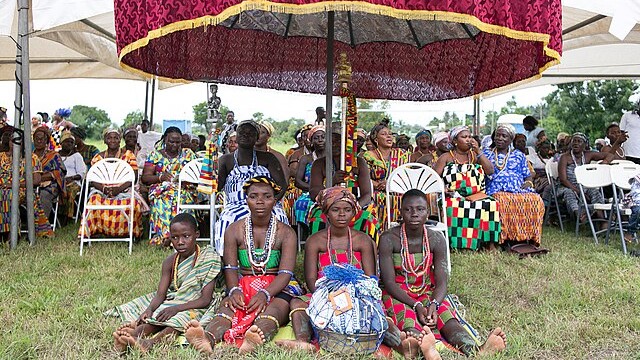In villages across Ghana’s Ashanti region, the steady rhythm of wooden looms fills the air. Hands move with practiced precision, guiding brightly dyed threads into place. The result is Kente, a textile whose bold colors and intricate patterns carry centuries of meaning. More than fabric, it remains a symbol of identity, resilience, and cultural continuity.
Kente weaving traces its origins to the Ashanti Kingdom, with traditions dating back as early as the 12th century. Early weavers worked with silk and even strands of gold, materials that underscored the cloth’s association with wealth and power. Today, cotton and rayon have become common substitutes, but the artistry itself—the measured weaving of threads into geometric, symbolic motifs—has endured largely unchanged.
Each cloth is as much a narrative as a garment. Designs often draw on proverbs, historical events, or images from the natural world. Color itself functions as a language: yellow for prosperity and fertility, green for growth, blue for peace, black for spiritual energy. A single strip of fabric might speak of renewal, remembrance, or harmony, depending on the weaver’s intention.
The cultural resonance of Kente extends far beyond the loom. Worn at weddings, graduations, funerals, and national celebrations, it has long marked moments of significance. In modern Ghana, Kente has also become a point of pride, its patterns adopted by politicians, artists, and diasporic communities across the globe. The cloth’s presence on international stages has elevated it into an emblem of African heritage and solidarity.
For artisans, weaving is not only cultural but also economic. Entire families in weaving communities such as Bonwire and Adanwomase depend on the craft, passing down techniques through generations. The sale of Kente—whether as bolts of cloth, scarves, or ceremonial garments—supports households and helps sustain traditional practices in the face of competition from mass-produced imitations.
Despite the pressures of globalization, the weaving tradition persists. Local initiatives promote Kente as both cultural heritage and economic resource, encouraging sustainable practices and protecting the authenticity of the craft. The survival of Kente weaving, in this sense, reflects broader conversations about safeguarding indigenous knowledge in a rapidly changing world.
Seen on a loom, a piece of Kente is still a work in progress—threads interlaced, stories in the making. Once complete, it becomes part of a larger tapestry, linking the present with the past. For Ghana, the cloth embodies not only artistry but the enduring values of community, memory, and resilience.
Sources:
- Ghana Museums and Monuments Board, Kente Weaving Traditions (official cultural heritage publication)
- Ross, Doran H., Wrapped in Pride: Ghanaian Kente and African American Identity, UCLA Fowler Museum of Cultural History, 1998
- National Commission on Culture, Ghana, Textile Heritage Report

